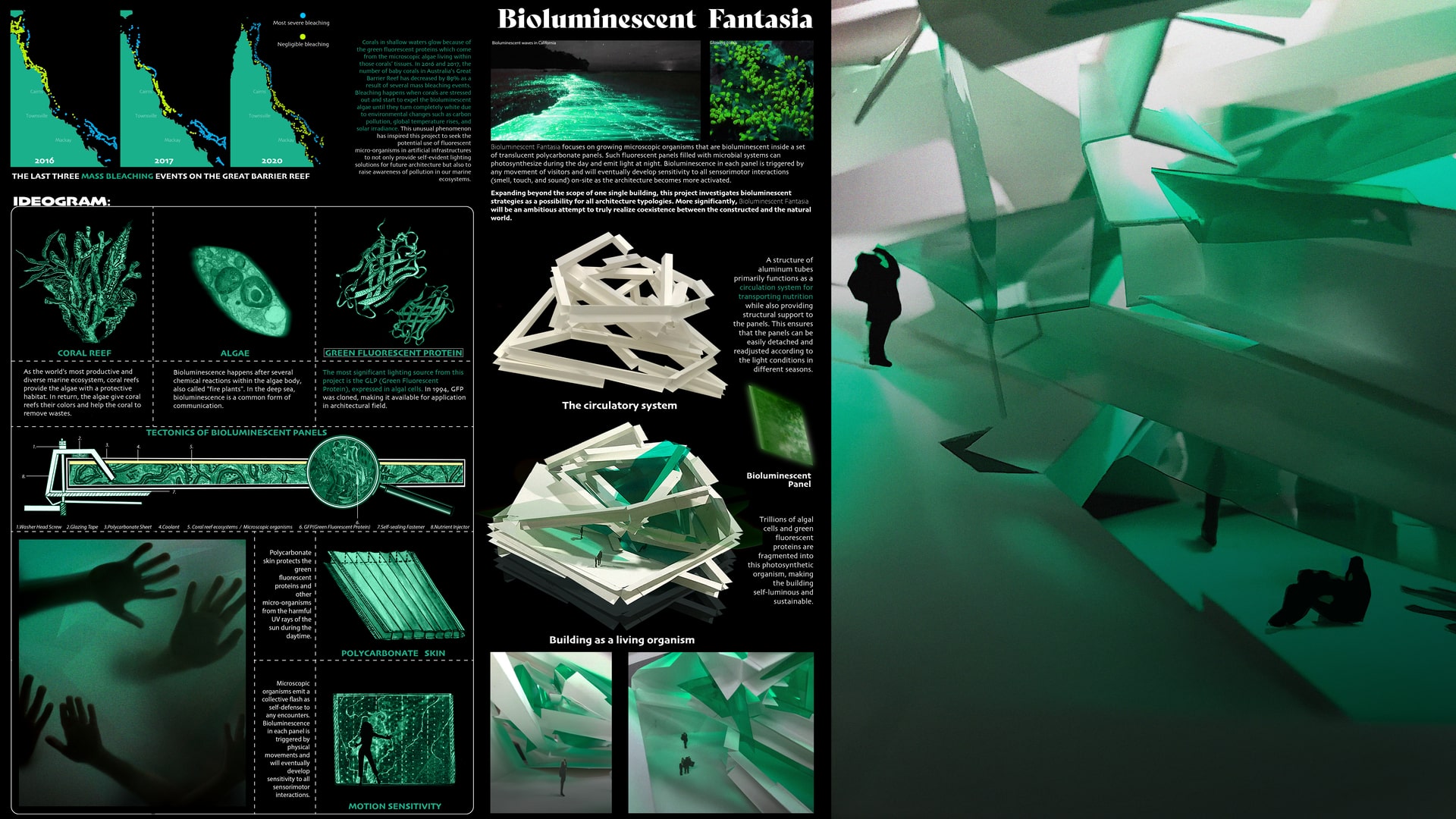Project Description
Corals in shallow waters glow because of the green fluorescent proteins which come from the microscopic algae living within those corals’ tissues. In 2016 and 2017, the number of baby corals in Australia's Great Barrier Reef has decreased by 89% as a result of several mass bleaching events. Bleaching happens when corals are stressed out and start to expel the bioluminescent algae until they turn completely white due to environmental changes such as carbon pollution, global temperature rises, and solar irradiance. As the world's most productive and diverse marine ecosystem, coral reefs provide the algae with a protective habitat. In return, the algae give coral reefs their colors and help the coral to remove wastes. When the algae are interrupted by the movement of any invader, they emit a bright bioluminescent glow. This unusual phenomenon has inspired this project to seek the potential use of fluorescent micro-organisms in artificial infrastructures to not only provide self-evident lighting solutions for future architecture but also to raise awareness of pollution in our marine ecosystems. The design starts with questioning the traditional green wall which is simply inserting plants into a growing medium and then placed on vertical space. While the green walls seem to merge architecture and nature on an introductory level, this project digs further into the microscopic world by growing microscopic organisms that are bioluminescent inside a set of translucent polycarbonate panels. Such fluorescent panels filled with microbial systems can photosynthesize during the day and emit light at night. Bioluminescence in each panel is triggered by any movement of visitors and will eventually develop sensitivity to all sensorimotor interactions (smell, touch, and sound) on-site as the architecture becomes more activated. A continuous structure of aluminum tubes primarily functions as a circulation system for transporting nutrition while also providing structural support to the panels. This ensures that the panels can be easily detached and readjusted according to the light conditions in different seasons. The tubes will also automatically cool the panels to counteract extra exposure and heat under harsh sunlight. Ideally, in this structure, no physical and logical boundaries will be found between the three-dimensional biosphere zone and built components. The whole building will soon emerge as one gigantic living and breathing organism. The most significant lighting source from this project is the GFP (Green Fluorescent Protein), expressed from algal cells. In 1994, the green fluorescent protein was successfully cloned for the first time, making it possible for this project to explore the limits of application of GFP in the architectural field. To construct the habitat for the micro-organisms, polycarbonate would be the perfect exterior material as it can protect the green florescent proteins and other micro-organisms inside from the harmful UV rays of the sun during the daytime. In reality, bleaching is not always a death sentence for corals. New studies show that corals will glow to attract the algae in the hope to re-establish the symbiosis between them during bleaching. In some other cases, algae emit a collective flash as self-defense to any encounters entering their territory. Each algal cell can emit a flash of light lasting up to 100 milliseconds, almost like a burglar alarm. In this project, trillions of algal cells and green fluorescent proteins are fragmented into this photosynthetic organism, making the building self-luminous and sustainable. However, the biggest challenge while Bioluminescent Fantasia continues to develop is that the cost of nutrition to feed the micro-organisms can be relatively high. One possible solution can be to introduce genetic transformation to change their eating habits. Expanding beyond the scope of one single building, this structural assembly investigates bioluminescent strategies as a possibility for all architecture typologies. More significantly, Bioluminescent Fantasia will be an ambitious attempt to truly realize coexistence between the constructed and the natural world.
